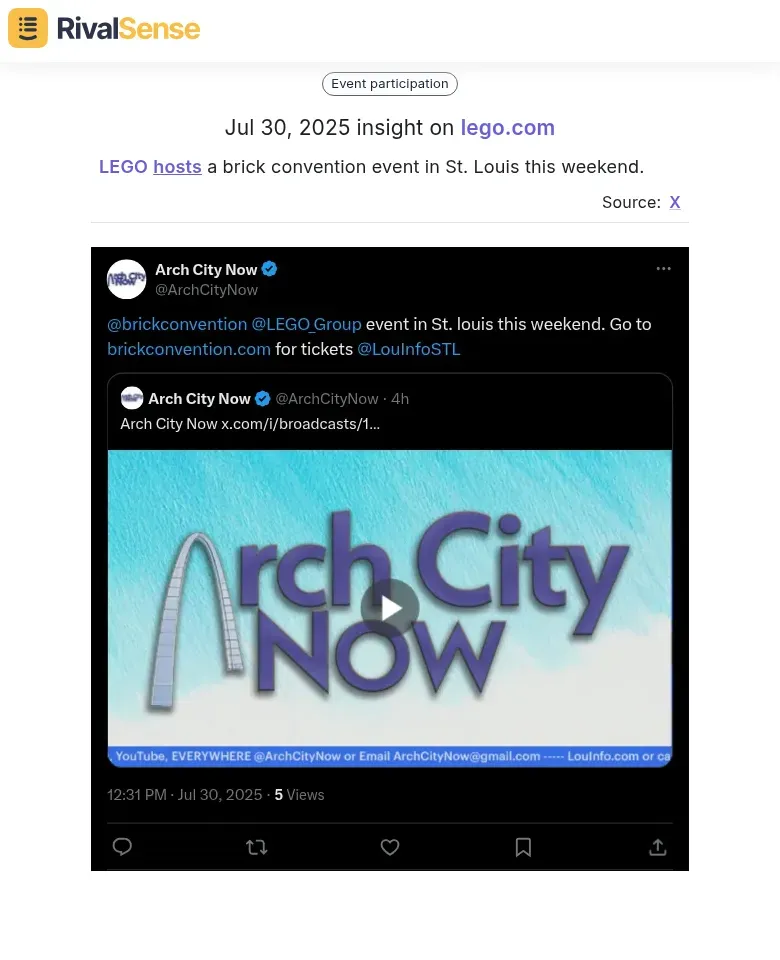Unlock Competitive Edge: Mastering Twitter Competitor Insights
In today's fast-paced digital landscape, Twitter has become an indispensable radar for tracking competitor moves in real-time. Monitoring competitors' Twitter activity delivers immediate strategic advantages by revealing marketing tactics, product launches, and engagement patterns. For B2B leaders, this real-time intelligence enables agile decision-making and proactive strategy adjustments to outperform rivals.
Twitter serves as a public laboratory for competitive experimentation, where announcements, campaigns, and customer interactions unfold live. By analyzing these activities, you can identify emerging trends, gauge market sentiment, and uncover strategic gaps in your own approach. For instance, a competitor's viral tweet about a new feature might expose unmet customer needs you can address faster.
Key insights from competitor tweets include:
- 🚀 Product Updates: Spot new features or services before official announcements
- 💬 Engagement Tactics: Discover content formats that resonate with audiences
- 🗣️ Customer Feedback: Identify pain points or praises from their followers
Actionable Framework:
- Set Smart Alerts: Monitor competitors' handles for instant notifications
- Analyze Hashtag Performance: Track campaign-specific tags to measure reach
- Benchmark Engagement: Compare likes/retweets to calibrate your content
- Map Posting Cadence: Reverse-engineer their content calendar timing
Event Participation and Industry Engagement
Competitor event strategies reveal critical insights about market priorities and resource allocation. Tracking conference participation, sponsorships, and speaking engagements exposes where rivals are investing thought leadership efforts. For executives, this intelligence helps anticipate market shifts and identify partnership opportunities before they materialize.
Systematic event monitoring uncovers hidden strategic alliances and positioning tactics. When competitors associate with specific brands or influencers at events, it signals emerging industry alliances worth watching. Their event messaging tone—whether innovation-focused or educational—also exposes brand positioning strategies you can counter.

LEGO hosts a brick convention event in St. Louis this weekend.
Why it matters: Tracking physical events reveals regional market focus and community engagement strategies, helping you anticipate expansion patterns.
Practical Playbook:
- Maintain dynamic event calendar with competitor participation
- Analyze post-event content for messaging consistency
- Reverse-engineer their ROI measurement tactics
✅ Event Tracking Checklist:
- [ ] Catalog industry events quarterly
- [ ] Monitor social/web for competitor announcements
- [ ] Deconstruct their partnership ecosystems
- [ ] Benchmark against your event ROI metrics
Innovation and Technology Trends
Twitter provides early warning signals about competitors' tech investments and R&D directions. Tech-related announcements and expo participation reveal where rivals are placing strategic bets. For tech-driven industries, tracking these patterns helps anticipate market disruptions and validate your innovation roadmap against emerging standards.
Analyze how competitors integrate new technologies into customer solutions—whether through enhanced features, service models, or engagement tools. The frequency and depth of their tech-focused content indicate commitment levels to specific innovations. Comparing their adoption timelines against yours exposes strategic gaps to address.

LEGO joins Starbucks and L'Oreal at IoT Tech Expo Europe 2025 to discuss connected retail.
Why it matters: Expo participation signals strategic tech investments, helping you anticipate industry shifts and partnership landscapes.
Innovation Audit Framework:
1. Set keyword alerts for tech announcements
2. Categorize innovations by type (AI/blockchain/IoT)
3. Map adoption timelines quarterly
4. Assess customer impact through engagement metrics
Vision and Thought Leadership
Executive communications on Twitter offer unparalleled access to competitors' strategic vision and future roadmaps. By monitoring leaders' tweets and interviews, you gain insights into long-term market perspectives that shape their decisions. For CEOs, this intelligence helps anticipate strategic pivots and identify positioning gaps in your own narrative.
Thought leadership content directly influences brand perception and customer trust. Competitors who consistently share visionary content position themselves as industry authorities, attracting talent and partnerships. Analyzing their thematic consistency reveals how effectively they align vision with execution.

Veriff shares vision for 'biometrically rich digital passport' for financial services.
Why it matters: Executive vision statements preview product roadmaps and market positioning, enabling strategic countermeasures.
Execution Blueprint:
- Track Leadership Accounts: Follow CEOs/CTOs for strategic signals
- Map Vision Themes: Identify recurring strategic priorities
- Analyze Engagement: Measure audience resonance of thought leadership
- Cross-Reference Channels: Validate Twitter insights with press releases
Practical Applications for Your Business
Transforming Twitter insights into competitive advantage requires systematic implementation. Begin by identifying 3-5 key competitors and tracking their tweet performance through specialized tools. Focus on engagement patterns, content themes, and posting cadence to benchmark your own strategy effectively.
Create a weekly analysis ritual: Review competitor highlights every Monday to inform your content calendar. When you spot high-engagement tactics—like influencer collaborations or educational threads—test similar formats with your unique spin. For example, if competitors gain traction with webinar announcements, counter with deeper technical demonstrations.
Implementation Matrix:
| Activity | Your Action | Metric |
|---|---|---|
| Competitor feature launch | Highlight your superior implementation | Engagement lift |
| Viral educational thread | Create advanced version with data | Share rate |
| Executive Q&A series | Host expert roundtable | Follower growth |
Conclusion and Next Steps
Mastering Twitter competitor intelligence creates sustainable competitive advantages through proactive adaptation. The insights uncovered—from event strategies to innovation bets—provide actionable blueprints for refining your market approach. Consistent monitoring turns reactive observations into strategic foresight.
To operationalize these insights:
- Schedule Biweekly Audits: Dedicate 30 minutes every other week
- Automate Tracking: Implement monitoring workflows
- Test & Iterate: Pilot one tactic monthly from competitor observations
- Measure Impact: Track share-of-voice changes quarterly
Accelerate Your Intelligence:
Ready to transform Twitter insights into competitive victories? Try RivalSense free and get your first competitor report today. Automate tracking of product launches, event strategies, and leadership moves—all delivered in actionable weekly briefings.
📚 Read more
👉 Strategic Insights: Benchmarking Zoom's Competitor Promotions in Video Communications
👉 Beginner’s Guide to Tracking Competitor Hiring & Layoffs
👉 Spotify's Audiobook & Video Push: What Competitors Need to Know
👉 Market Intelligence for Strategic Decision Making: Turning Data into Action
👉 Avoid These 5 Mistakes When Creating E-Commerce Competitor Profiles
